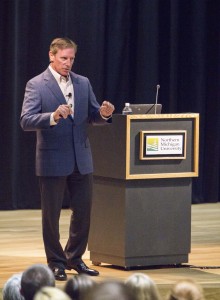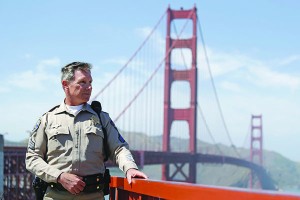Kevin Briggs spent 20 years patrolling the Golden Gate Bridge as a California State Highway Patrolman. He responded to over 500 potential suicide jumpers, but the two he lost stand out in his mind.
“I remember one gentleman, he was well dressed, African-American, not under the influence,” Briggs said. “I hadn’t had a whole lot of training (at that point). We spoke to this guy, and he kept telling us he needed to jump to see his grandmother. He shook my hand three times, on the third time he said, ‘Kevin, I want to thank you. But I need to go,’ and he jumped.”

Briggs watched as the man fell. “I can’t exactly tell you why. But one reason is because the waters below the Golden Gate bridge are treacherous. I want to make sure that we can locate that body.”
When Briggs first began patrolling the Golden Gate Bridge in 1994, he wasn’t unaware of the suicide numbers that occur on the bridge, but after he received his first call of a potential jumper, he knew he needed to learn how to respond to such calls better.
“I was scared, because I had no training whatsoever on how to handle it,” Briggs said. “I pretty much learned it on the job.” Briggs recalls his first jumper call.
“The woman was in her mid-30s and was standing on the end rail,” Briggs said. “I walked straight up to her, like a cop would normally do, but whatever I did, it made her come back.”
This experience was an eye opener for Briggs, who then sought feedback from the district on what he could have done better in the situation.
Briggs noted that most suicide jumps occur when people are off their medications or when another ailment affects them like alcoholism, drugs, homelessness, etc.
Since its opening in 1937 nearly 1,600 people have jumped to their deaths at the Golden Gate Bridge, according to the Los Angeles Times. This total only accounts for the number of bodies that have actually been recovered by officials.
“So the number of people that have jumped is actually higher,” Briggs said, emphasizing that if there is no body recovered, it isn’t counted.

(John Storey: San Francisco Chronicle)
In June of this year, the Golden Gate Bridge board of directors approved a plan to install a net under the bridge railing to prevent jumpers. Some criticized that it would deter from the bridge’s beauty, while others wanted a preventative barrier. Briggs said that he personally didn’t favor the measure at first.
“I didn’t want the view ruined, until a gentlemen came up to me and told me that he lost his daughter on the bridge,” Briggs said. “He asked for my view and I told him that the vast majority of folks who come up to the bridge are not suicidal. He then told me that it was between the bridge view or a life. From that point on my view has changed. I think it’s going to be a good thing.”
At Brigg’s talk at NMU on Wednesday, Oct. 22, he discussed how people can be more aware of suicide in their lives and the lives of people around them. He offered a piece of advice.
“Just educate yourself,” Briggs said. “Be aware of the people around you. I didn’t know about things happening in my own life until it was brought to my attention. We need to step back and really look at things.” Briggs has since retired from the California Highway Patrol to concentrate on suicide prevention.


























Sylvester • Nov 5, 2015 at 1:42 pm
A fascinating discussion is definitely worth comment. There’s no doubt that that you should write more on this topic,
it might not be a taboo matter but usually people do not talk about these issues.
To the next! Cheers!!